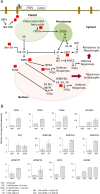Molecular Responses to Small Regulating Molecules against Huanglongbing Disease
- PMID: 27459099
- PMCID: PMC4961454
- DOI: 10.1371/journal.pone.0159610
Molecular Responses to Small Regulating Molecules against Huanglongbing Disease
Abstract
Huanglongbing (HLB; citrus greening) is the most devastating disease of citrus worldwide. No cure is yet available for this disease and infected trees generally decline after several months. Disease management depends on early detection of symptoms and chemical control of insect vectors. In this work, different combinations of organic compounds were tested for the ability to modulate citrus molecular responses to HLB disease beneficially. Three small-molecule regulating compounds were tested: 1) L-arginine, 2) 6-benzyl-adenine combined with gibberellins, and 3) sucrose combined with atrazine. Each treatment contained K-phite mineral solution and was tested at two different concentrations. Two trials were conducted: one in the greenhouse and the other in the orchard. In the greenhouse study, responses of 42 key genes involved in sugar and starch metabolism, hormone-related pathways, biotic stress responses, and secondary metabolism in treated and untreated mature leaves were analyzed. TGA5 was significantly induced by arginine. Benzyladenine and gibberellins enhanced two important genes involved in biotic stress responses: WRKY54 and WRKY59. Sucrose combined with atrazine mainly upregulated key genes involved in carbohydrate metabolism such as sucrose-phosphate synthase, sucrose synthase, starch synthase, and α-amylase. Atrazine also affected expression of some key genes involved in systemic acquired resistance such as EDS1, TGA6, WRKY33, and MYC2. Several treatments upregulated HSP82, which might help protect protein folding and integrity. A subset of key genes was chosen as biomarkers for molecular responses to treatments under field conditions. GPT2 was downregulated by all small-molecule treatments. Arginine-induced genes involved in systemic acquired resistance included PR1, WRKY70, and EDS1. These molecular data encourage long-term application of treatments that combine these regulating molecules in field trials.
Conflict of interest statement
Figures




References
-
- Bove’ JM. Huanglongbing: A destructive, newly-emerging, century-old disease of citrus. J Plant Pathol. 2006;88:7–37.
-
- Jagoueix S, Bové JM, Garnier M. The phloem-limited bacterium of greening disease of citrus is a member of the alpha subdivision of the Proteobacteria. Int J of Syst Bacteriol. 1994;44:397–86. - PubMed
-
- Folimonova SY, Achor D. Early events of citrus greening (Huanglongbing) disease development at the ultrastructural level. Bacteriology. 2010;100:949–58. - PubMed
-
- Albrecht U, Bowman KD. Gene expression in Citrus sinensis (L.) Osbeck following infection with the bacterial pathogen Candidatus Liberibacter asiaticus causing Huanglongbing in Florida. Plant Sci. 2008;175:291–306.
MeSH terms
Substances
LinkOut - more resources
Full Text Sources
Other Literature Sources

